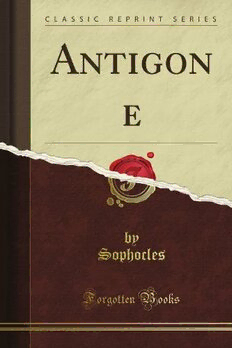
Antigone PDF
207 Pages·2010·1.977 MB·English
Most books are stored in the elastic cloud where traffic is expensive. For this reason, we have a limit on daily download.
Preview Antigone
Description:
REVIEW OF TUB PLAY.11Aeschylus only one actor was employed, and in this play we find Creon (1G2, 766, 1091), and afterwards the messenger (1155, 1244), alone upon the stage in a colloquy with the Chorus. The third actor was introduced first by Sophocles. In the Antigone the three actors are together on the stage only in the second epeis'odion, and even there only two persons at a time (not counting the Chorus) are engaged in the dialogue; the guard remains silent as soon as Antigone begins to speak, and so does Antigone when words pass betweeii Ismene and Creon. The parodos contains anapaestic verses, the regular rhythm in Greek marches, and states the occasion of the entrance of the Chorus. This is the old form. The Chorus announces the entrance of all the principal persons, except in the case of Tiresias. The anapaestic and iambic verses that conclude mclic strophes are likewise in strophic correspondence. Sophocles has avoided only in this play a change of speaker within the liTable of Contents THE OLD VITALISMAbout the Publisher Forgotten Books is a publisher of historical writings, such as: Philosophy, Classics, Science, Religion, History, Folklore and Mythology.Forgotten Books' Classic Reprint Series utilizes the latest technology to regenerate facsimiles of historically important writings. Careful attention has been made to accurately preserve the original format of each page whilst digitally enhancing the difficult to read text. Read books online for free at http://www.forgottenbooks.org
See more
The list of books you might like
Most books are stored in the elastic cloud where traffic is expensive. For this reason, we have a limit on daily download.
